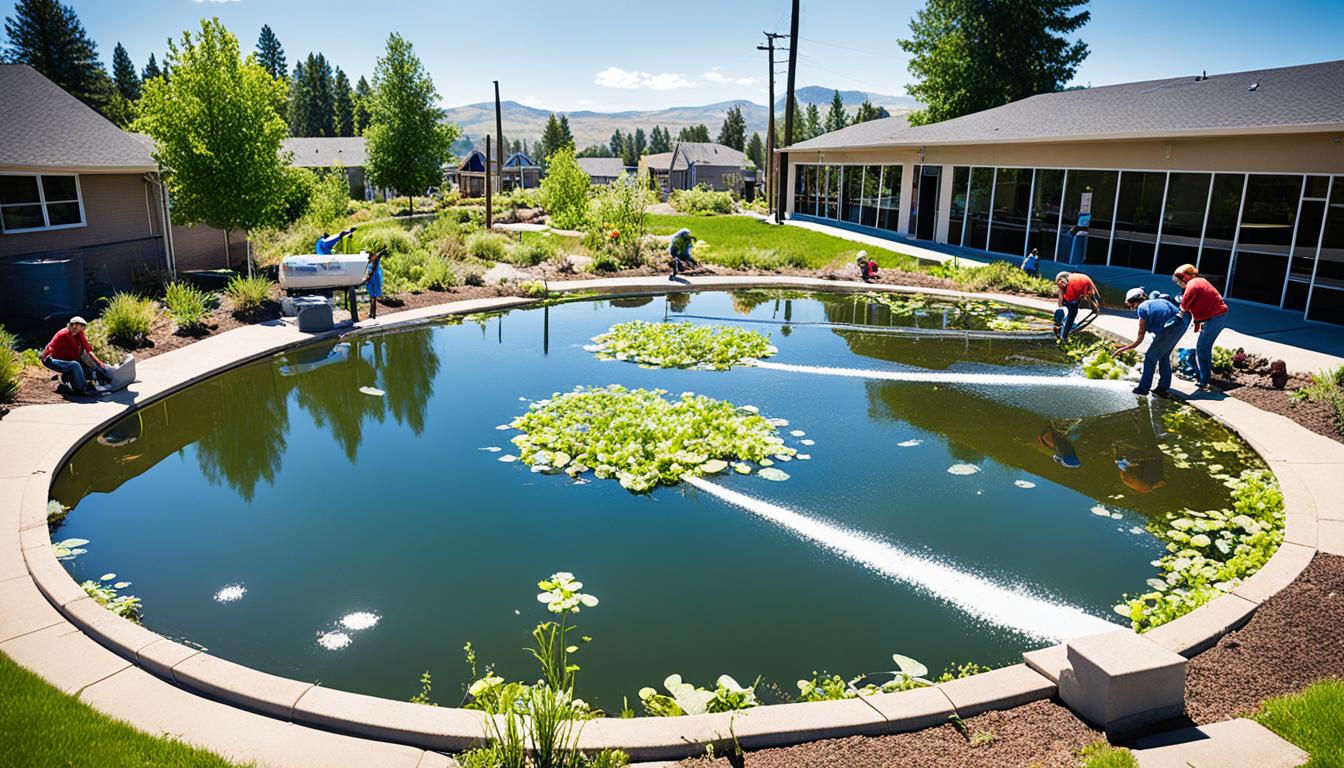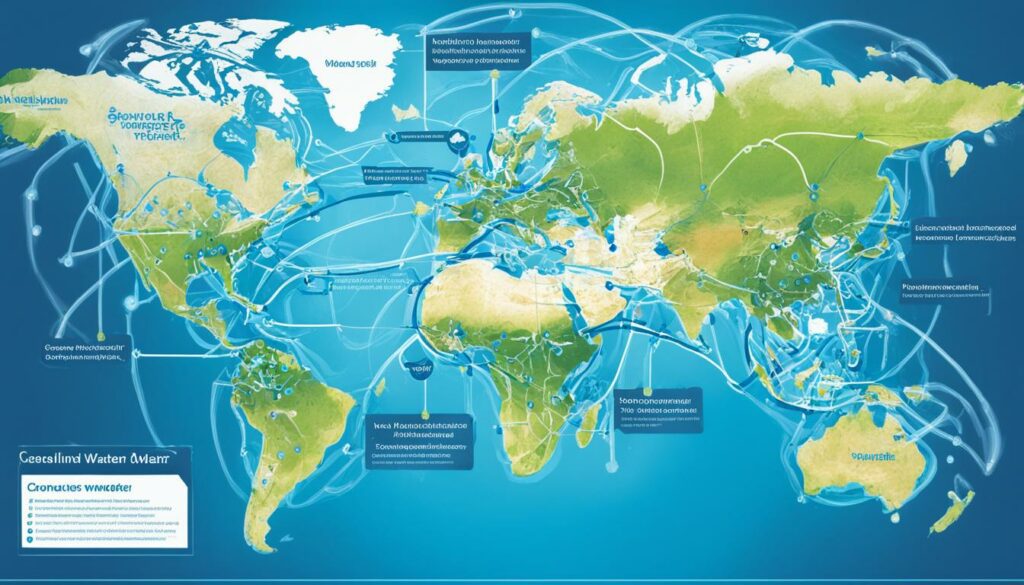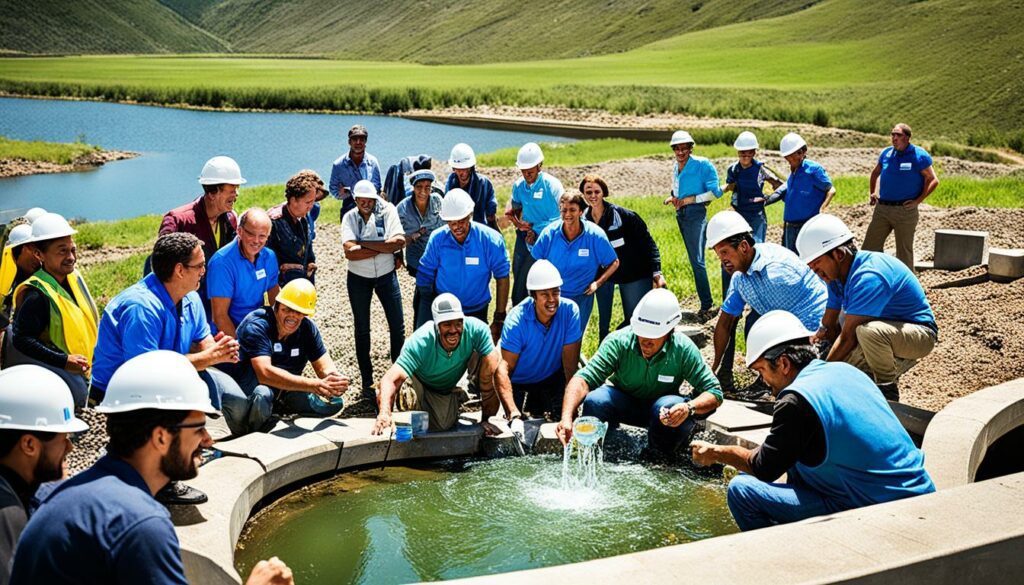Menu

Do you know that Integrated Water Resources Management (IWRM) is more than just theory? It’s a hands-on method that changes how we look after water. It encourages the smart use of water, land, and more to boost economies and help communities. This happens without harming the vital life systems that depend on water. Social fairness, making smart use of money, and protecting the environment are its main goals. It makes water a force for good in societies and industries.
Looking after water in a sustainable way needs a strategic plan. We must combine different ways to deal with less water and a changing environment. As climate change makes things tougher, we need new ways to manage water. This is where integrated water management steps in. It offers a roadmap to handle these challenges and create a future where everyone uses water fairly and wisely.
Integrated Water Management (IWM) looks at water resources in a comprehensive way. It aims to support water sustainability, integrate water systems, and make sure water is shared fairly. According to the Global Water Partnership, it brings together the use and care of water, land, and resources. It supports economic and social progress while protecting our precious ecosystems.
At its core, Integrated Water Management blends many disciplines and people together. It treats water as a valuable but limited resource. It involves everyone in decisions about water. This ensures plans meet the needs of communities and nature. It also looks at how cities can change water systems, affecting how water flows and its quality.
IWM is crucial in today’s world. We face big challenges like water shortages, pollution, and climate change. We urgently need water systems that work well and protect the environment. The growth of cities makes these issues bigger, but it also opens the door to new, smart solutions. IWM makes sure water is shared equally, especially with those who have less. It protects nature, keeping our water systems healthy for the future.
IWM includes key elements:
Choices about how we use the land really affect water. Planners, engineers, and people who build things in cities need to work together. They must include water needs in their planning. IWM needs lots of different groups to team up. This way, we get the most from drinking water and nature without hurting the environment.
Here’s a good look at what’s key in IWM:
| Component | Description |
|---|---|
| Water Supply Systems | Bringing water from the ground or rivers for people to use. |
| Wastewater Management | Making sure water we’ve used doesn’t pollute rivers or the ground. |
| Stormwater Management | Handling rainwater that can carry pollutants. |
| Water Conservation | Saving water we already have by teaching about it and having rules to protect it. |
Integrated Water Management underlines how everything in our water systems is linked. It suggests a way that meets our needs today and tomorrow without harming the environment. By following the ideas of fairness, good economics, and protecting nature, we can keep our water healthy for the generations ahead.
Integrated Water Management (IWM) aims to balance environmental, economic, and social factors. This helps achieve water practices that meet everyone’s needs while saving the environment. The main principles are social equity, economic efficiency, and ecological sustainability.
Ensuring equitable water distribution among all is key. IWM includes everyone, especially women, in managing and protecting water. This makes sure water use meets everyone’s needs, supporting community welfare.

Using financial and water resources well benefits everyone. Water is viewed as an economic good to set its price fairly. This includes using government help and fees for users to manage water wisely.
Taking care of the water systems is vital for the environment. This principle ensures water use doesn’t harm ecosystems. River Basin Organizations (RBOs) help manage water across areas to keep the environment healthy. They watch closely to make sure water strategies are good for nature and people.
| Member Organizations | Countries | Funding Options |
|---|---|---|
| 133 | 50 | Government grants, User charges, Basin environmental trust funds, Donor funds |
Today, we face big challenges in managing water resources. These include scarcity, overuse, and climate change impacts. They require smart solutions to meet human, economic, and environmental needs. Let’s look closer at these hurdles.
Scarcity of water is a big issue around the globe now. The world’s need for water keeps growing, putting a strain on fresh water sources. This leads to water quality problems and arguments over who gets how much. Droughts add to the trouble, harming crops, increasing costs, and causing social issues.
Looking towards the future, technology will be key in solving water issues. By 2024, digital tools will greatly help with water management. Things like decision support systems and smart water management offer hope. They help us plan better and use water more efficiently, which is critical to fight water scarcity.
Climate change is making water problems worse, affecting weather patterns. This leads to events like flash floods and long droughts. For example, flash floods cause big losses globally. These changes will make it harder for some places to get the water they need.
For these extreme events, early warning systems are crucial. They give us a heads up on potential emergencies. By 2024, these systems will be better thanks to advanced technology. This will make forecasts more precise, helping us prepare and react faster to water issues.
Working together globally is very important too. If countries join forces, they can deal with water challenges more effectively. This teamwork can help control the effects of climate change on water resources.
Effective strategies for sustainable water use are key parts of Integrated Water Management (IWM). They include new ways to save water and making farming more water-efficient. These are big steps towards using water wisely.

Using less water involves many different methods. For example, modern systems to water plants, collecting rainwater, and planting crops that don’t need much water. Teaching the public how to save water is also important. It helps change our habits to ones that use less water.
We can make farming use water better by doing a few things. One is precision irrigation, which means we only water the crops where and when they need it. This stops water from being wasted. Also, managing nutrients in the soil can help save water. By using new tech and old wisdom together, farmers can help use water more wisely.
| Strategy | Projected Water Savings by 2060 (acre-feet) |
|---|---|
| Surface Water Strategies | 3 million |
| Groundwater Reliant Strategies | 800,000 |
| Municipal Conservation | 650,000 |
| Irrigation and Other Conservation | 1.5 million |
Looking at the table, it’s clear that using water better and saving it means we will have more by 2060. These steps are really important for farming and making sure we have enough water for the future.
The design of water infrastructure is crucial for Integrated Water Management (IWM). It’s important to know the needs of many different users to create a solid plan. Water strategies for the future must meet current needs while preparing for tomorrow.
It’s key that politicians support these plans. The report “Pathways to One Water: A Guide for Institutional Innovation” shows how countries like the US and Australia succeed. Teams from various fields are vital for making integrated water planning work well together.
The report “Understanding six water leadership roles” tells us about key leadership in water management. Leaders should push for good water infrastructure and make sure all groups work together. This idea is highlighted in “Moving Toward Collaboration: A New Vision for Water Management in the Los Angeles Region.”
It’s vital for everyone to join in and for laws to fit our changing needs. We need to be flexible to keep up with the move towards sustainable water systems. A well-thought-out plan is critical for a strong and green water future.
To wrap it up, good water infrastructure planning needs everyone on board, legal support, and political backing. By strengthening these points, we can shape a water world that uses the best of today’s ideas and stands the test of time.
Urban water systems are complex and need a holistic approach for their management. This involves combining supply, sanitation, stormwater, and wastewater management with planning and development. The United Nations’ Sustainable Development Goals, especially Goal 6.5, stress the need for this integration. They aim for everywhere to use water resources wisely by 2030.
The Water Action Hub supports an approach called Integrated Urban Water Management (IUWM). This method looks at water use in a wider context, aiming to solve many issues at once. Compared to traditional ways, IUWM does a better job at handling problems like drought and poor water quality. It also prepares for challenges from population growth. Experts agree that IUWM is vital for creating water systems in cities that can cope with current and future needs.

Applying IUWM can be tough because of issues like finding new water sources, legal barriers, and costs. But, it’s a solid answer for managing city water wisely. With the right tech, like tools for tracking rainfall and managing water, cities can get better at handling their water use.
Also, there are set ways to check how well cities are doing in managing their water. These checks make sure the water quality is top-notch and that water services are cost-effective. For example, the “2021 Infrastructure Report Card” by the American Society of Civil Engineers calls attention to the nine billion dollars of flooding damage in the US every year. It highlights the need for good stormwater management. With more than 40% of people worldwide facing water shortages, we must adopt sound urban water practices.
| Urban Water Management Aspects | Traditional Approaches | IUWM Approaches |
|---|---|---|
| Integration Level | Fragmented; individual aspects managed separately | Holistic; integrated with city planning and economic development |
| Adaptability to Change | Limited adaptability | Highly adaptable to current and future challenges |
| Benefits to Communities | Less impactful | Significant benefits including improved water quality, security, and conservation |
| Technical Tools | Basic tools | Advanced tools including integrated water modelling platforms |
Cities like Copenhagen changed their approach to stormwater after floods. This shows how beneficial IUWM methods can be. More than 40 US states have set up stormwater utilities. This shows a growing awareness of the importance of managing stormwater and the support available through funds.
In conclusion, urban water management must be holistic and integrated. By linking city and basin management, cities can handle water issues better. This ensures there’s enough water for future use.
Water recycling and reclamation drive forward integrated water management. They make use of the latest technologies. The process turns wastewater into a valuable resource. This has a big impact on our economy and environment. It helps in managing water in a sustainable way.
Many people are now focused on water reclamation technology. Recent data shows that 60% of water industry experts aim to reuse and recycle water. Also, there’s a big increase in exploring ways to reuse water over five years.
Advanced oxidation is a key method in water recycling. It uses techniques like UV light combined with hydrogen peroxide or ozone gas. These methods make wastewater safe to use again. But it’s important to know not all oxidation methods can break down all organic materials in water. There are different types of oxidants, each with its own strengths and abilities. These include chlorine, chloramine, ozone, permanganate, chlorine dioxide, and ferrate.
Water reuse brings many economic benefits. For example, the Orange County Water District in California treats waste water for its uses. This ensures water security and provides financial gains.
Using reclaimed water is also good for the environment. In Florida, 820 million gallons of reclaimed water supported public endeavours in 2019. Reusing water like this helps lessen the pressure on clean, fresh water. It also reduces the impact of disposing wastewater on the environment.
Yet, the high cost is a major challenge for broad water reuse adoption. This is especially true for smaller utilities. Making an economic case for water reuse and investing in it are crucial. But there are more grants today to help start these projects. These grants support long-term, sustainable water management.
| Statistic | Data |
|---|---|
| Percentage of stakeholders with water reclamation goals | 60% |
| Stakeholders exploring water reuse more than five years ago | Two-thirds |
| Reclaimed water used in Florida (2019) | 820 million gallons |
| Daily treatment by Orange County Water District | 100 million gallons |
| Planned expansion for Orange County Water District | 130 million gallons per day |
We must combine innovative water recycling with smart economic strategies. This ensures we get the most out of water reuse. It’s key to maximising the benefits for our future.
Taking a look at global water management practices next to local water management case studies shows us we need many different ways to manage water. Both big, worldwide projects and small community efforts have lessons to share about successful water management.

In Southern Alberta, Canada, the Bow River Basin is a model of smart water use. With 400-500 mm of rain each year, it plans with the Bow River Integrated Model (BRIM) for its water future. It gives 46% of water to farms, cities, and businesses showing good use of shared water principles.
Myanmar has lots of land and water, with 1082 km³ of surface water and 495 km³ underground. Despite this, they face water issues like floods and not enough water in some places. The National Water Resources Committee (NWRC) in Myanmar is working with experts to solve these problems and get better at managing water.
Communities do a great job in looking after their own water with special plans and ways of working together. In Myanmar, locals study how much water they have underground to use it better. These efforts show how important local people are in making water plans work well and last long.
Everywhere, when communities join in to manage water, they have big wins. These wins help in the short and long run, making sure water is used well for the future. This is key for solving water issues that all regions face.
Managing water resources well needs strong political and legal foundations. Having leaders committed to this cause and having good laws is key. They help create fair ways to handle water and adjust to new problems.
Rules and laws are needed for creating better water policies. It’s important to have regulations that make everyone work together better. Through these rules, important plans for water use and involving everyone are shaped. This makes sure water plans work for everyone.
Creating water management plans needs careful thought and the ability to change as needed. Policy makers focus on making rules that meet today’s needs and look to the future. Putting money into training and staying financially strong is vital. Good policies solve problems and help use water wisely.
For IWM to work well, communities need to be part of water management. This means getting many different people involved in making decisions. By doing this, the rules and ways we manage water reflect what everyone needs. This makes water management fair and open for everyone.
Local communities are key to making water management sustainable. By using what they know and getting them actively involved, addressing water problems becomes easier. This approach uses the strength of the community to create better, more fitting solutions.

Arnstein’s ladder shows how involved citizens are in water work, from just showing they’re involved to having real power. When communities are partners or have power, they manage water better for the long term.
Women bring special ideas and goals to water care. Seeing the importance of women in this area is vital. It means they should help in all areas of planning and doing water work. This makes water care better and gives power to everyone in communities.
The ways we get people to join in must be able to change. They should mix what we know about people with what we know about technology. Things like meetings with many different groups or groups that look after water help a lot. UNESCO says approaches like IRBM are key to making water work for everyone.
Thinking carefully about who should be part of planning and how makes the plan stronger. This can involve talking with people, listening to them, and understanding how they connect with others. Though it’s hard and takes a lot of work, making sure everyone’s voice is heard is very important for IWM to do well.
Getting funds for water projects is crucial for their success and long-term support. This money comes from many places, such as partnerships between the public and private sectors and international help. They ensure there’s enough money for these important projects.
Working together, public and private groups can raise money for water infrastructure. An example is Sydney Water working with Jemena to make biomethane from wastewater. This shows how we can find value in what we normally consider waste. This approach follows the idea of a circular economy, which supports long-lasting and green investments in water.
The U.S. Department of the Interior recently funded six projects for better water storage and transport in three states. This not only shows the power of working together but also highlights the impact of a new law. This law will use over $50 billion to make water systems better across the country.
Getting money from around the world is key for many areas that need help with water projects. When California received $307 million for fixing piples, making channels, and upgrading pumps, it marked the importance of global support. And when the Minnesota Public Facilities Authority gave $191 million to fix water and other public systems, it echoed this same message.
Don’t forget the private companies. In Texas, for example, the Water Development Board got $222.3 million for water work due to the Infrastructure and Jobs Act. San Antonio Water System is also investing $200 million to make its systems better and ready for the future.
Encouraging people and companies to pay for goods made from water can also support a circular economy. This approach not only helps the environment but also finds new ways to finance water projects and solutions.
Here’s a table with some of the important investments made:
| Location | Funding Amount | Project Type |
|---|---|---|
| California | $307 million | Water Infrastructure Improvements |
| Minnesota | $191 million | Infrastructure Repairs |
| Texas | $222.3 million | Water Projects |
| San Antonio | $200 million | Resiliency Initiatives |
| Sydney | – | Biomethane Production from Wastewater |
The way we manage water is changing a lot, thanks to new tech. These innovations help make smarter decisions based on data. A study of 3771 startups and businesses in water management found the top 8 trends for 2024. Among these, Digital Water Management is key. It uses smart water systems with AI, IoT, and smart meters for real-time analysis and improvement of water networks.
New smart water technologies are changing how we look at and use water. For instance, companies using AI like PipePredict are leading in spotting leakages digitally. This cuts down on wasted water. Then, there are innovative agricultural water management solutions by businesses such as SPHERAG. They use IoT and cloud services to make farming more efficient. Advanced drones and weather radars are also being used to prevent floods. These innovations show how new tech is affecting water management worldwide.
In 2024, using data for decisions in the water sector will be a must. Now, water treatment plants are getting more automatic. And in places that handle wastewater, using data analytics in water management is becoming crucial. Big data and advanced analytics help water utilities work better and greener. Nanoseen and Warranium are excelling in water cleaning and disinfection. They use advanced filters, pushing forward water technology innovations.
Digital transformation is very important as it brings complete solutions for managing water resources. In a world where water is more scarce, these advances help sustain and optimize water use. They boost the economy and the environment too. The mix of smart devices and data analytics is changing how we manage water. This leads to a future in water management that is more flexible and effective.
Integrated Water Management (IWM) helps develop water, land, and resources together. It focuses on fair economic and social growth without hurting the environment. It aims to keep a balance between people’s needs, economic benefits, and nature’s health.
IWM is key today because it deals with tough issues like water shortage, climate change, and harm to the environment. It helps use water fairly, wisely, and in a way that won’t run out. This keeps water healthy for our children and grandchildren.
IWM’s main ideas are about making sure everyone can get water (Social Equity), using money and water well (Economic Efficiency), and keeping nature how it should be (Ecological Sustainability). These ideas help make sure water is managed in a way that’s good for everyone and the planet.
Climate change is making it harder to manage water well. It changes when and how much it rains, makes extreme weather more common, and affects how much water we can use. To deal with this, we need to adjust how we manage water to make sure we have enough and it stays healthy.
Good ways to save water are using less, smarter ways to water plants, fixing leaks, and collecting rainwater. These help cut down on how much water we use and help keep water sources healthy.
Using water well in farming is important because it uses a lot of water. By farming in smarter ways and using crops that don’t need as much water, we can save a lot. This helps make sure there’s enough water for growing food and nature.
Planning water systems plays a big role in IWM, making sure they work well for everyone. It means thinking ahead, getting support from leaders, and working together on building strong and smart water systems.
Reusing water saves money and helps the environment. New ways of cleaning and reusing water turn waste into something we can use again. These methods also help protect water resources for the future.
There are great examples globally, from large organisations to local groups showing good IWM. They show how working together in a smart, fair way can lead to lasting and good water management.
Laws and politics set the rules for using and managing water. Good water management needs strong, flexible laws to protect water in a way that deals with new challenges well.
Talking and working with communities, especially women, is important for good IWM. It brings many perspectives together, making plans and projects better for people and nature.
Water project money comes from working with the government, companies, and international groups. This support means projects can happen and keep going, helping to use water well for a long time.
New tech like smart systems and using data helps manage water better. It gives us ways to see how to use water smarter, meeting the needs of people and nature while saving water.